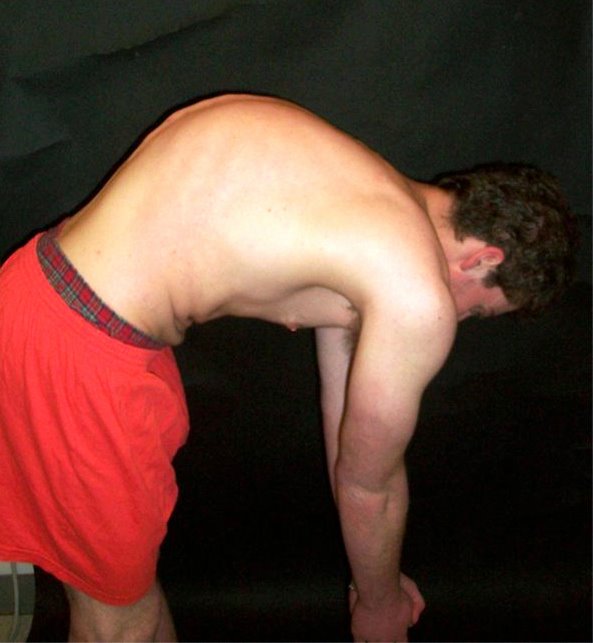Article reviewed and approved by Dr. Ibtissama Boukas, physician specializing in family medicine
Sometimes overlooked, Scheuermann's disease is however one of most common causes of dorsal kyphosis in young people of puberty age. Find out everything there is to know about this pathology in this article.
Definition and anatomy
To better understand this condition, it helps to start with some basic anatomy.
La spine begins at the level of the skull and extends into the pelvis. The column contains 33 vertebrae with discs cartilaginous between each vertebra. These help to absorb and distribute shocks and to prevent the vertebrae de rub during the movement.
It is normal that the spine curves back and forth. For some people, especially teenagers. However, some of them have the thoracic spine (located in the chest area) that curves too much (more than 40-45 degrees) giving the impression of having a bump on the back. That's what we call Scheuermann's disease.
It is a condition that develops over time during periods of bone growth (as the puberty). It occurs when the front of your spine does not grow as fast as the back of the spine.
As a result, healthy vertebrae which would normally have a rectangular shape take on a triangular shape et huddle against each other. This causes a great curvature of the thoracic spine (a leaning posture).
The causes of Scheuermann's kyphosis
To this day, scientists are still struggling to know the exact causes of Scheuermann's kyphosis.
Hypotheses suggest that the disease has something to do with a interrupted bone growth or an abnormality in development and growth of vertebrae. This condition seems to be héréditaire. The height and weight can also be contributing factors.
The Danish doctor Scheuermann, who discovered the disease in 1920, also mentioned a theory that a lack of blood in the cartilage around vertebral body was the cause of the jam. However, scientists have challenged this theory.
Finally, there are also various factors of risks as :
- juvenile osteoporosis (decreased bone mass);
- malabsorption nutrients useful for the good development of the body;
- infections which reach the bones;
- to trauma;
- to prolonged sitting positions and carrying heavy loads;
- to endocrine system disorders: biochemical changes in the collagen that make up the endplates altering bone growth, higher than average disc height, and increased levels of growth hormone)
Symptoms of Scheuermann's disease
Since the Scheuermann's disease occurs during periods of bone growth, it often appears for the first time at adolescence at the time of puberty. The symptoms usually develop between 10 and 15 years and may include:
- appearance formation bossu back ;
- stiffness in the back after prolonged sitting;
- pains when performing activities that require twisting;
- Cramps muscle;
- reduced flexibility;
- balance problems light;
- hamstrings contracted.
When it gets complicated, Scheuermann's disease can cause of chronic back pain, neurological deficits and progressive deformations.
After surgery, the most common complication is pseudoarthrosis.
Diagnosis of Scheuermann's disease
Before a definitive diagnosis can be posed, the doctor will list the medical background to help rule out other conditions that may have similar symptoms.
Physical exams
Here are the physical exams useful for diagnosing Sheuermann's disease.
- A forward bend test: Your child leans forward at the waist. This may reveal a thoracic kyphosis or thoracolumbar.
- A palpation: also called practical exam, it allows to determine the abnormalities of the spine by touch. During the Scheuermann's disease, the thoracic area of the spine is accentuated.
- A range of motion test: the doctor evaluates to what extent the patient can lean forward, back and side to side.
Imaging exams
Personalized x-rays of the spine are also necessary to complete the diagnosis. For this, the doctor performs AP X-rays (anterior/posterior) full length spine. The child stands with his arms stretched forward while keeping his head straight.
X-rays may also be done while your child is lying down to determine the curve flexibility and vertebral impingement.
The curvature of the kyphosis is measured in degrees. A curvature without abnormality of the vertebrae (and which disappears easily when the patient lies down) is generally considered postural. However, the Scheuermann's disease is confirmed if a patient has:
- a kyphotic curve of 50° or more;
- three adjacent vertebrae or more who get stuck together with at minus 5° per segment (15° in total over three segments);
- small herniated discs through the vertebral endplates (called Schmorl's nodes).
Treatment of Scheuermann's disease
Your doctor will develop a personalized treatment plan for your child based on:
- the size and progression of the curve;
- age;
- the amount of growth left to the child;
- the level of pain;
- the effect of the curve on the child's appearance;
- the risk of cardio-pulmonary or neurological problems.
Observing and monitoring
If your child has a slight curvature that should not get worse or cause problems with daily activities, your doctor will likely recommend a simple observation.
Unless the curvature or pain is getting worse, no further treatment is needed.
Equipment and exercise
A splint is more effective when used before the skeleton reaches maturity around the age of 14.
Some exercises such as general conditioning et stretching are also useful for help patients control pain. Basic training for stabilization of the spine is an important part of the pain management program.
However, exercises alone do not reduce the kyphosis in the Scheuermann's disease.
Anti-inflammatories
Personalized anti-inflammatory drugs are prescribed for your children to ease the pain. They are generally used short term, a combination with other treatments.
surgery
If your child is not improving after 6 months of non-surgical treatments such as braces and physical therapy, the doctor may recommend surgery in the following cases:
- curve enlargement (more than 70°) causing moderate or severe pain;
- risk of neurological problems associated with the disease.
The operation to correct Scheuermann's disease consists of to fuse the vertebrae :
- posterior fusion: surgery on the back (posterior) of the spine;
- combined fusion: two fusion surgeries, one from the back (posterior) and one from the front (anterior) of the spine.
What are the sequelae in adulthood following Scheuermann's disease?
Some children who do not need treatment eventually get better and have no long-term problems. Others may still have a mild thoracic kyphosis, but do not provide any pain nor embarrassment.
Children and adolescents treated without surgery will continue physical exercises such as:
- upper back exercises: gentle, gradual back extensions can improve posture and prevent the spine from sagging forward;
- hamstring stretches and pelvic exercises improve posture by preventing additional lordosis in the lower back. Aerobics improves heart and lung health, and reduces pain.
Rehabilitation after surgery is more complex. Of treatment sessions after the operation help patients to learn to move and perform routine activities without putting additional pressure on the back. A physiotherapist is best suited to support you. Furthermore, wearing a back orthosis or a support belt may be considered.
When surgery is necessary, the final results are generally favorable. Complications are rare, but can include:
- an infection ;
- loss of correction;
- spinal cord injury;
- other neurological problems.
Resources
References
https://www.passeportsante.net/fr/Maux/Problemes/Fiche.aspx?doc=maladie-scheuermann


